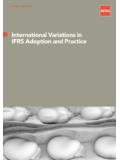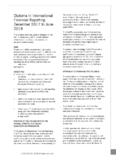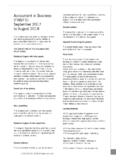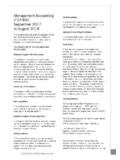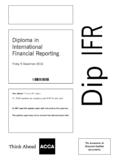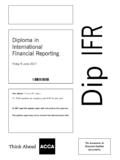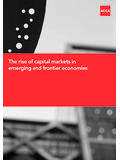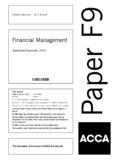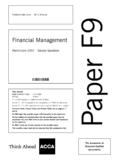Transcription of Culture- governance tool - ACCA Global
1 TTCulture- governance +44 (0)141 582 2000 acca 2016 Why culture ?Corporate culture encourages certain behaviours that support or impede the achievement of organisational objectives. The challenge is finding how to nurture a culture that promotes behaviours consistent with organisational and nurtureACCA culture governance TOOLGOVERNANCE DIAGRAMABOUTHOW THE tool WORKSHOW DO WE START?WHY culture ?Tone, processes and proceduressupportBehaviourOrganisational objectivesProcesses and procedures matterProcesses and procedures that people can see and experience in their professional lives need aligning with the objectives of organisations. Inconsistency between the two creates dysfunctional behaviour. This culture governance tool has been developed to show the relationship between the two, and help an organisation to assess its culture and initiate a positive change.
2 acca 2016 Organisational processes and proceduresHow the tool worksThe circular form of the tool represents an organisation. Inner circle: corporate leadership Middle layer: governance lenses Outer circle: organisational processes and proceduresACCA culture governance TOOLGOVERNANCE DIAGRAMABOUTHOW THE tool WORKSHOW DO WE START?WHY culture ? This circle contains the four tenets (tone at the top, mission, performance management, and communication) of responsibility for corporate leadership. These directly affect corporate culture . Corporate leadership comes from both the board and senior management. They are equally important in our discussion of corporate culture . The outer circle shows organisational processes and procedures, many of which everyone in an organisation sees and experiences, and which collectively represent an organisational culture . The layer in the middle is a set of governance lenses.
3 These lenses can help in analysing and introducing changes to corporate at the topMissionPerformance managementCommunicationFour tenets of responsibility acca 2016 Inter- connectionsSustainabilityAccountability and trustRisk-taking and transparencyOrganisational valuesTGovernance diagram You can return to this page by clicking on the governance Diagram tab in the contents culture governance TOOLGOVERNANCE DIAGRAMABOUTHOW THE tool WORKSHOW DO WE START?WHY culture ?Click on any of the governance lenses to find out more. For example, clicking on the Organisational values lense will reveal examples of processes and procedures that relate to organisational values. The examples are separated into two sets: one more closely associated with interconnections between people and the other with risk-taking and transparency. Clicking on on the page will take you to a further explanation of what organisational values mean for corporate leadership and for the rest of the organisation.
4 acca 2016 Organisational processes and proceduresInter- connectionsSustainabilityAccountability and trustOrganisational valuesRisk-taking and transparencyTone at the topMissionPerformance managementCommunicationFour tenets of responsibilityDecision-making and handling of challenge/diversityCollective sense-making and identity buildingFormal and informal norms/sub-culturesAlignment with individual valuesPeer pressurePerformance measurement and time framePeople management and talent retentionTraining/recruiting/sub-contrac tingReward and remunerationIncentives and sanctionsRisk appetiteOrganisational valuesAn organisation has its values, often linked to what it does as a business and how it does it. This includes its attitudes towards internal and external can be a powerful source of organisational at the topMissionPerformance managementCommunicationACCA culture governance TOOLGOVERNANCE DIAGRAMABOUTHOW THE tool WORKSHOW DO WE START?
5 WHY culture ?- acca 2016 Inter- connectionsSustainabilityAccountability and trustOrganisational valuesRisk-taking and transparencyTOrganisational valuesCorporate leadershipThe mission, values and objectives of an organisation typically embody the organisation s values. The board is responsible for setting them, as well as abiding by them to set the tone for the leadership is responsible for ensuring that the necessary resources are in place, whether for recruiting and developing people or rewarding communicated organisational values will enable the rest of the organisation to adhere to them of the organisationPeople experience organisational values in their everyday life at work. For example, an organisation recruits, trains and rewards people: HR practice sends out a direct and powerful message about what the organisation values about people and their are involved in making decisions, either alone or in a team.
6 The criteria people use in decision-making originate in the organisational values cascaded-down or interpreted in their own hierarchy formalises such processes. It also embodies the trust bestowed on people taking organisational values develop into norms and sub- culture over time. People may align their individual values, or may choose to reject the culture governance TOOLGOVERNANCE DIAGRAMABOUTHOW THE tool WORKSHOW DO WE START?WHY culture ? Decision-making/handling of challenge/diversity Collective sense-making and identity- building Formal and informal norms/sub-cultures Alignment with individual values Organisational structure Performance measurement and time frame People management and talent retention Training/recruiting/sub-contracting Reward and remuneration Incentives and sanctions Risk appetite acca 2016 TPeer pressureRisk recognition and responseVisibility of accountability mechanismsApplication of rules and procedures/flexibility and choicesConsistency of behaviour and expected level of commitmentInternal control and monitoring/relationship with auditorsRisk-taking and transparencyACCA culture governance TOOLGOVERNANCE DIAGRAMABOUTHOW THE tool WORKSHOW DO WE START?
7 WHY culture ?An organisation expects the people within to have the balance of skills and knowledge necessary to carry out their tasks, including taking risks. People s risk-taking depends on the organisation s risk appetite and how individuals understand it. Transparency about the organisational risk appetite and associated controls enhances a consistent risk approach across the arrangementsTone at the topMissionPerformance managementCommunicationInter- connectionsSustainabilityAccountability and trustOrganisational valuesRisk-taking and transparency acca 2016 Performance measurement and time framePeople management and talent retentionTraining/recruiting/sub-contrac tingReward and remunerationIncentives and sanctionsRisk appetiteRisk-taking and transparencyCorporate leadershipThe board is directly responsible for maintaining risk-management and internal control systems.
8 It identifies principal risks and determines the organisation s approach, including the rewards and sanctions, at a high communication of these policies from corporate leadership helps the rest of the organisation to understand and practise a consistent risk approach and to introduce controls in day-to-day of the organisationPeople understand how they should approach risk by seeing how the organisation responds to risk-taking. This includes incentives and control measures in place and rewards and sanctions in relation to the transparent and consistent approach to risk helps people align their idea of what is acceptable risk-taking with that of the organisation. Watching how the theory turns into practice reinforces the examples range from resource allocation, training and awareness-raising of risk, to implementation of rules and procedures, and speak-up arrangements.
9 acca culture governance TOOLGOVERNANCE DIAGRAMABOUTHOW THE tool WORKSHOW DO WE START?WHY culture ? Performance measurement and time frame People management and talent retention Training/recruiting/sub-contracting Reward and remuneration Incentives and sanctions Risk appetite Internal control and monitoring/relationship with auditors Consistency of behaviour and expected level of commitment Application of rules and procedures/flexibility and choices Visibility of accountability mechanisms Risk recognition and response Whistle-blowing arrangements Peer pressure acca 2016 Accountability and trust acca culture governance TOOLGOVERNANCE DIAGRAMABOUTHOW THE tool WORKSHOW DO WE START?WHY culture ?Accountability of an organisation and trust in the organisation go hand in hand. Where an organisation is accountable to its internal and external stakeholders for its decisions, conduct and outcomes, trust in the organisation pressureRisk recognition and responseVisibility of accountability mechanismsApplication of rules and procedures/flexibility and choicesConsistency of behaviour and expected level of commitmentInternal control and monitoring/relationship with auditorsWhistle-blowing arrangementsTone at the topMissionPerformance managementCommunicationInter- connectionsSustainabilityAccountability and trustOrganisational valuesRisk-taking and transparency acca 2016 Feedback mechanisms Focus on performance versus reputation Sensitivity to external and internal events TAccountability and trustCorporate leadershipThe board identifies the internal and external stakeholders of the organisation to whom it is accountable.
10 Typically, in the mission statement, the board communicates: what the organisation sets out to do how this may affect the stakeholders, and how it intends to account for the becomes the basis of quantitative and qualitative measurement of performance. Rules, procedures and their implementation are often built around the benefits for the of the organisationA clear indicator of how people perceive accountability is the way in which they relate to each other and to the people treat each other with respect, they will interact in an open and direct manner. This supports professional behaviour at organisation in which professional behaviour prevails is likely to be more resilient against threats to itself (eg fraud) and to engage external stakeholders in a consistent culture governance TOOLGOVERNANCE DIAGRAMABOUTHOW THE tool WORKSHOW DO WE START?WHY culture ?
